These sourdough hot cross buns are made without commercial yeast: only sourdough starter! They have a lovely spiced dough that’s flecked with dried fruit, and topped with that traditional cross!
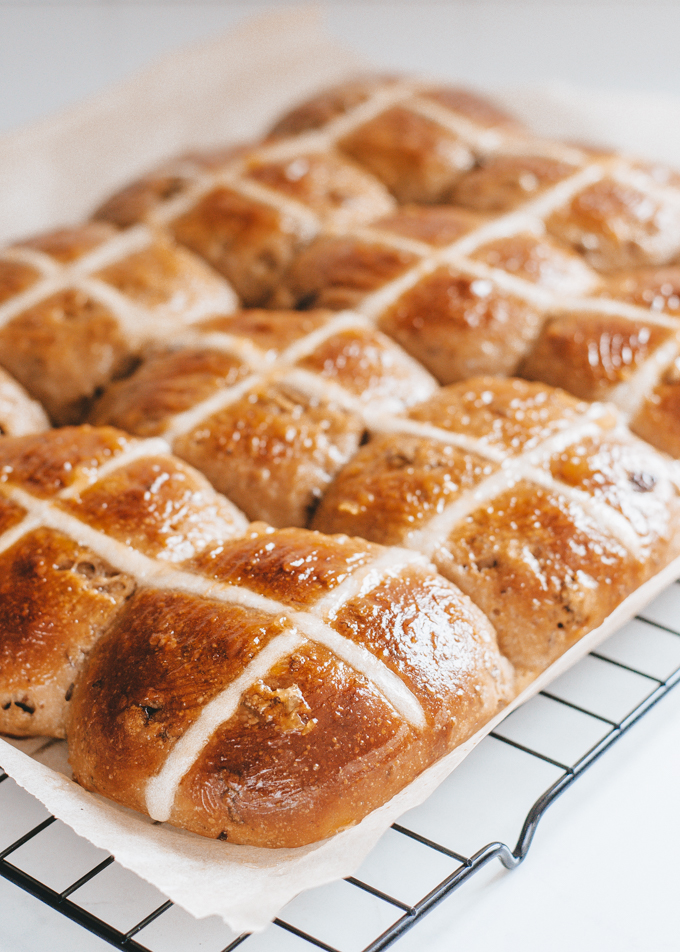
Growing up, my grandma would always (or nearly always) make Hot Cross Buns for Easter.
I remember eyeing them suspiciously. They contained raisins, and I was a raisin critic at the time.
Now it’s come full circle, and I’ve developed my own sourdough hot cross buns recipe!
Here’s What We’ll Cover in This Post:
What Are Hot Cross Buns?
Traditional hot cross buns are yeasted sweet buns that have a spiced dough that’s flecked with dried fruit. The buns are topped with a cross and eaten on Good Friday (or Easter in some circles).

Note: Some links are affiliate. All opinions are my own. If you click a link and make a purchase, I will earn a small commission. This has zero impact on the price you pay, and it helps Buttered Side Up out! Thank you!
What is the White Stuff on Hot Cross Buns?
The cross on hot cross buns is made of either a flour paste or a powdered sugar icing. For the flour paste, you pipe it on before the buns are baked. The powdered sugar icing is piped on after the buns are baked and cooled.
What Does the Cross Mean?
Traditionally, the cross is said to symbolize the cross that Jesus died on. The spices in the dough are also said to symbolize the spices that anointed his body.
Ingredients:
For the Dough
- 240 g Active sourdough starter: This is what we’ll be using in place of yeast! See below for an explanation of what your starter should look like.
- 245 g Warm whole milk: You don’t want the milk super warm. Just take the chill off of it in a pan over the stove.
- 440 g All-purpose flour: I like to use organic all-purpose flour since it’s easier on the beneficial yeast and bacteria in sourdough.
- Sugar: I used a mixture of dark brown sugar and organic cane sugar.
- A whole egg: This add to the richness of the dough.
- Cinnamon: I used Vietnamese cinnamon, which is stronger than “regular” cinnamon, so if you’re using a different variety you may want to increase the amount.
- Nutmeg, cloves, and cardamom: I added a sprinkling of these spices as well.
- Unrefined sea salt: I use Redmond Real Salt.
- Pure vanilla extract: Please don’t use imitation vanilla!! Yes, that warrants two exclamation points.
- Currants or Raisins: You can use any dried fruit you like, but I like currants since they’re smaller. If you opt for raisins, roughly chop them. I’ve also heard of people using chocolate chips in place of the dried fruit, and I think that sounds lovely. Maybe with a coffee-flavored glaze or icing? A cranberry and orange hot cross bun combination would be lovely as well!
- Soft salted butter: I know that many bakers prefer unsalted butter, but I don’t keep it on hand at all times because I despise it spread on bread. So it’s easier for me to just use what I have on hand. Of course I use grass-fed butter 99.9% of the time.
You’ll also need an egg for an egg wash, and flour and water for the flour paste cross if you go that route.
You can also add a bit of (organic) orange peel to the batter if you want a citrus flavor right in the dough.
And if you want to glaze your buns you’ll need either a simple syrup or apricot jam.
If you decided to do an icing cross, here’s what you’ll need:
- Powdered sugar
- Milk or cream
- Pure(!!) vanilla extract
- Unrefined sea salt
How to Make Sourdough Hot Cross Buns
Not gonna lie, these buns are a little more involved with several steps. But they’re definitely worth it for an Easter/Good Friday treat!
Okay, let me show you how to make them!

Feeding the Sourdough Starter
First, you’re going to need an active sourdough starter. An active starter is one that has been fed 8-12 hours previously, has doubled in volume, is active and bubbly, and passes the float test.
8-12 hours before you mix together the dough, feed your sourdough starter.
If you don’t have a sourdough starter yet make sure to check out my How to Make a Sourdough Starter From Scratch post!
I like to feed 80 grams of starter with 90 grams each of flour and water. This gives me the 240 grams of starter I need for the recipe, plus a bit extra.
Important Note: I keep my starter at 100% hydration, which means I feed it equal weights, not volumes, of water and flour. If you you don’t keep your starter at 100% hydration, simply feed it equal weights of flour and water for this recipe, and then go back to your regular feeding schedule.

Wait until your starter has doubled and is active and bubbly before using it.

See how bubbly it gets?!

Mixing the Dough
Place the remaining dough ingredients except for the butter in the bowl of a stand mixer.

Fit your stand mixer with the dough hook and knead the dough for 3 minutes.
It will start out as a shaggy dough, but come together as you mix it.

Next, add the softened butter, 1 tablespoon at a time.
Wait until the butter is incorporated before adding the next tablespoon.
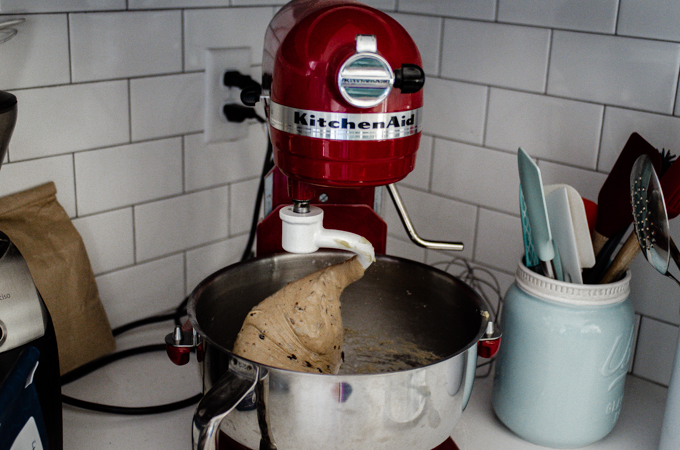
Knead for 15-20 more minutes, or until the dough passes the windowpane test.

To perform the windowpane test, grab your dough and stretch it out. You should see light through it before it starts to tear.

First Rise (AKA Bulk Fermentation)
Scrape the dough into a greased large bowl.

Cover with either plastic wrap, a damp tea towel, or a lid and let dough rise until doubled, about 6-12 hours (depending on how warm your kitchen is).
If your kitchen is quite warm, it may only take 4-6 hours to ferment. And if it’s quite chilly, it may be more like 10-12 hours.
If your kitchen is particularly cold, you may want to put your dough in a warm place in your kitchen such as next to the stove or on top of the refrigerator.
On the other hand, if your kitchen is really warm, you may want to find a cool place for the bulk rise.
Also, this is an enriched dough, so it may take longer than your regular sourdough bread to rise since butter and milk can slow down fermentation.

Forming the Buns
Now it’s time to form the buns into equal pieces!
The next day, or after your hot cross bun dough is done fermenting, weigh your dough and divide that weight by the number of buns you want to make.

I made 12 buns, which worked out to about 97 grams per bun.
That makes quite large buns, so if you prefer something smaller, I suggest dividing them into 15.
Make sure to place the dough balls either on a lightly floured work surface or a piece of parchment paper to prevent sticking. This is quite a soft dough!
Quick tip: You may find that your need to use greased or wet hands to be able to handle the dough.
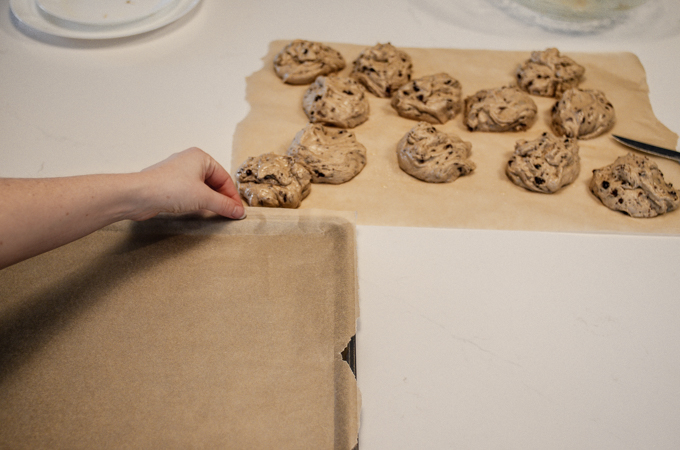
Line a rimmed baking tray with parchment paper.
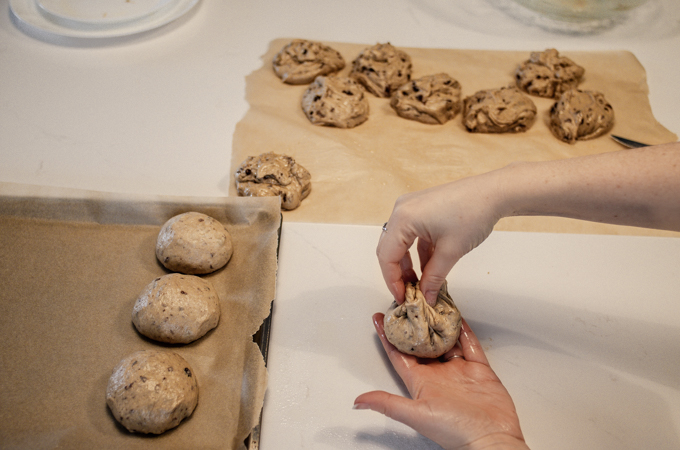
Grab one of the pieces of dough and pinch the corners into the middle.

Now cup your hands around the ball and roll it on your counter.
This creates surface tension, resulting in a nice smooth ball.

Transfer the buns onto the prepared baking tray.
You can put them closer together if you want the buns taller.

Second Rise (Final Rise)
Cover and allow to rise for 4-8 hours, or until they’re quite puffy.
Again, this will vary greatly depending on how warm your kitchen is!

Egg Wash
Beat an egg with a bit of water.
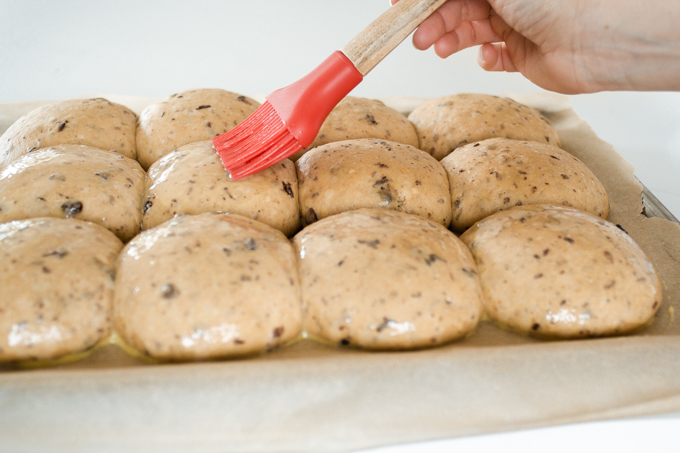
Using a pastry brush, brush the tops of the buns with the egg wash.
This helps them to brown nicely in the oven.

Making the Flour Paste Cross
If you opt for the flour paste cross, you’ll need to make it now.
Whisk together 1/2 cup of flour and 3-5 tablespoons of water to create a paste.
You don’t want the paste too thin, otherwise it will run off of the buns. But you don’t want it so thick that you can’t pipe it either.
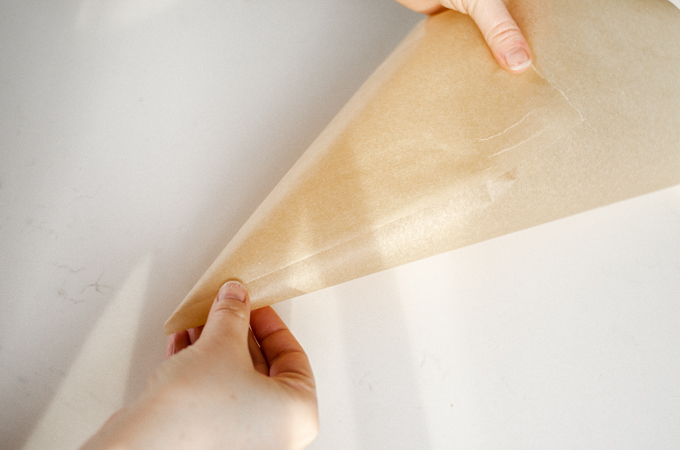
You can make a parchment paper cone for piping the crosses.
Or you could use a piping bag if you already have one on hand.

Or just cut the corn off of a plastic zipper top bag.

Pipe crosses on top of the egg washed buns, going right down the middle.

Baking
Bake the buns in a 375°F oven for 23-25 minutes, or until they’re golden brown and register 200°F in the middle.

Remove to a wire rack to cool.

Glazing
While the buns are still warm, you can brush them with a simple syrup or warmed apricot jam.
I like to use the jam because then you don’t have to make a simple syrup. Also, apricot jam tastes lovely.
You could even grate some orange zest or lemon zest on top for a punch of citrus flavor!

Making the Icing Cross
Now this is completely optional, but you can pipe an icing cross on top as well.
Honestly, you don’t need to do both types of crosses.
If I were to choose between the two, I would probably go with the icing cross though.
I like the bit of extra sweetness. Also, the flour cross tends to get a bit tough and difficult to chew.

To make the icing cross, sift 1/2 cup of powdered sugar into a small bowl.

Add 1-2 tablespoons of milk, 1/4 teaspoon vanilla extract, and a pinch of salt.

Again, you don’t want the icing to be either too thin or too thick.

Pipe on the crosses the same way you did the flour paste ones.

My Grandma would make hot cross buns with the icing cross, so perhaps that’s partly why I’m biased towards them.

And there you have some fluffy sourdough hot cross buns!
Look how soft these are!
And look at those cute currants dotting the insides.

Leftover Hot Cross Buns
If you have any leftover hot cross buns, not to fear! They’re actually delicious toasted!
Just be careful because the icing can burn in the toaster, and it can get hot enough to burn your mouth.
Storing:
You can store them in an airtight container at room temperature for a day.
But after that it’s a good idea to place them in the refrigerator or freezer.
Video Tutorial:
Here’s a video tutorial in case you learn better that way:

Suggested Baker’s Schedule:
The Day Before:
- 2:00 in the Afternoon: Feed your starter.
- 10:00 in the evening: Mix together the dough. Allow to ferment overnight.
The Day Of:
- 6:00 in the morning: Form the dough into balls. Allow to ferment.
- 12:00 in the afternoon: Bake the buns.
More Sourdough Recipes:
- Soft Sourdough French Bread
- Sourdough Pull Apart Rolls
- Soft Sourdough Sandwich Bread
- Overnight Sourdough Waffles
- Sourdough Cranberry Orange Rolls
- Pumpkin Sourdough Pull Apart Loaves
- Sourdough Brioche
- Artisan Sourdough Bread
- Sourdough Banana Bread
- Sourdough Donuts
Printable Recipe:
Sourdough Hot Cross Buns
Hot cross buns with a sourdough twist!
Ingredients
For the Dough
- 1 cup (240 grams) active sourdough starter (see note)
- 1 cup warm whole milk (245 grams - no more than 110°F)
- 3 cups organic all purpose flour (440 grams)
- 3 tbsp organic dark brown sugar
- 3 tbsp organic cane sugar
- 1 egg (pastured preferred)
- 1 tsp cinnamon (I used Vietnamese cinnamon)
- 1/4 tsp nutmeg
- 1/4 tsp cloves
- 1/8 tsp cardamom
- 1 1/2 tsp unrefined sea salt (I use Redmond Real Salt)
- 2 tsp pure vanilla extract
- 3/4 cup currants or raisins
- 1/4 cup soft salted butter (57 grams)
For the Egg Wash
- 1 egg
For the Flour Paste Cross
- 1/2 cup all-purpose flour
- 3-5 tbsp water
For the Glaze
- simple syrup or warmed apricot jam
For the Icing Cross
- 1/2 cup powdered sugar
- 1-2 tbsp milk or cream
- 1/4 tsp pure vanilla extract
- 1 pinch salt
Instructions
For the Dough:
-
Feed your starter 8-12 hours before mixing together the dough.
-
Place all of the dough ingredients except for the butter into the bowl of a stand mixer fitted with a dough hook.
-
Knead on medium-low for 3 minutes. Slowly add the soft butter 1 tablespoon at a time, waiting until each tablespoon is fully incorporated before adding the next tablespoon.
-
Continue kneading for 15-20 more minutes, or until the dough passes the windowpane test.
-
Scrape the dough into a large greased glass bowl. Cover and allow to ferment at room temperature for 6-12 hours (depending on how warm your kitchen is), or until doubled.
-
Line a rimmed baking sheet with parchment paper.
-
Weight the dough and divide that weight by the number of buns you want to make. That works out to about 97 grams for 12 buns.
-
Take a piece of dough and pinch the corners into the middle for form a ball. Roll the ball, seam side down, on your work surface to create surface tension. Transfer the buns to the prepared baking sheet. The closer you place the buns, the taller they'll be.
-
Cover and allow the buns to rise for 4-8 hours, or until they're quite puffy.
-
30 minutes before the buns are done rising, preheat your oven to 375°F (190°C).
For the Egg Wash:
-
Whisk an egg with a bit of water. Brush the buns with the egg wash.
For the Flour Paste Cross:
-
In a small bowl, whisk together the flour and water. Add enough water to make a paste that's thin enough to pipe, but not so thin that it will run off of the buns.
-
Pipe crosses on the buns, going straight down the middle of the buns.
-
Bake in the preheated oven for 23-25 minutes, or until the buns reach an internal temperature of 200°F (93°C)
-
Transfer the buns, parchment paper and all, to a wire cooling rack.
Glaze
-
While the buns are still warm, brush them with either a simple syrup or warmed apricot jam.
For the Icing Cross:
-
In a small bowl, whisk together all of the icing ingredients. Again, you want a consistency that's able to be piped, but not so thin that it runs off of the buns.
-
Once the buns are completely cool, pipe the icing crosses in the same way as the flour paste crosses.
Recipe Notes
An active sourdough starter is one that has been fed 6-12 hours in advance, is bubbly and active, has doubled, and passes the float test.
Updated on January 6, 2023

Peter Ellis
Wednesday 24th of March 2021
Hi Erica, I made your Easter Hot Cross Buns today and they were a winner. I cooked them at 180 C fan forced and they were a bit browner than yours so will cut it back to 170 fan next time. My dough was also a little wetter/sticky than yours and I had difficulty shaping the rolls. However I know what to do to fix that and my wife loves them. So thank you for the recipe and the detailed instructions. Peter (in a very wet Canberra, Australia)
Kylea Van Styn
Tuesday 2nd of January 2024
@Erica Kastner, I’m from the USA living in Australia. Typically it cooks a little hotter and more evenly from what I’ve found. So for things needing to be 180 conventional you cook at 160. I think there is an advantage with the fan keeping the heat consistent and making things even. Less frequently getting a hot spot in the oven. I’m currently trying this recipe sitting out for tonight. I needed to add quite a bit more flour as it was very sticky. I didn’t weigh it while mixing but I assume 75ish grams more. Though it’s very humid at the moment and so could be a big factor to the dough being extra sticky.
Erica Kastner
Wednesday 24th of March 2021
So happy you and your wife enjoyed them, and thank you for telling is what you did! Some day I'd like to wrap my head around the fan - it's not a feature that our US ovens have! Do you think there's an advantage to it?